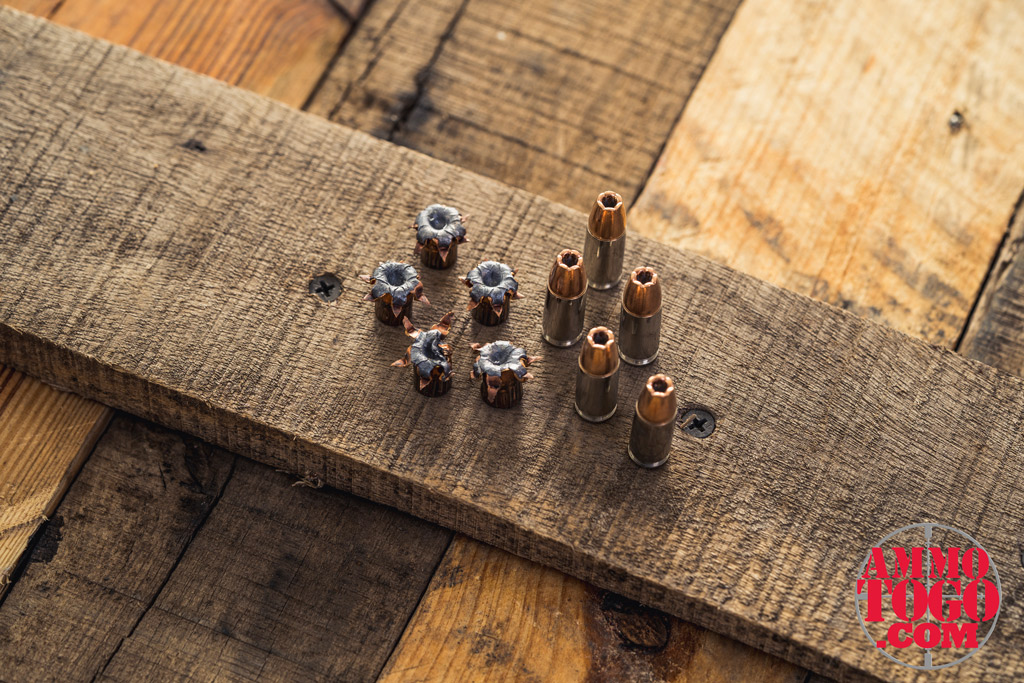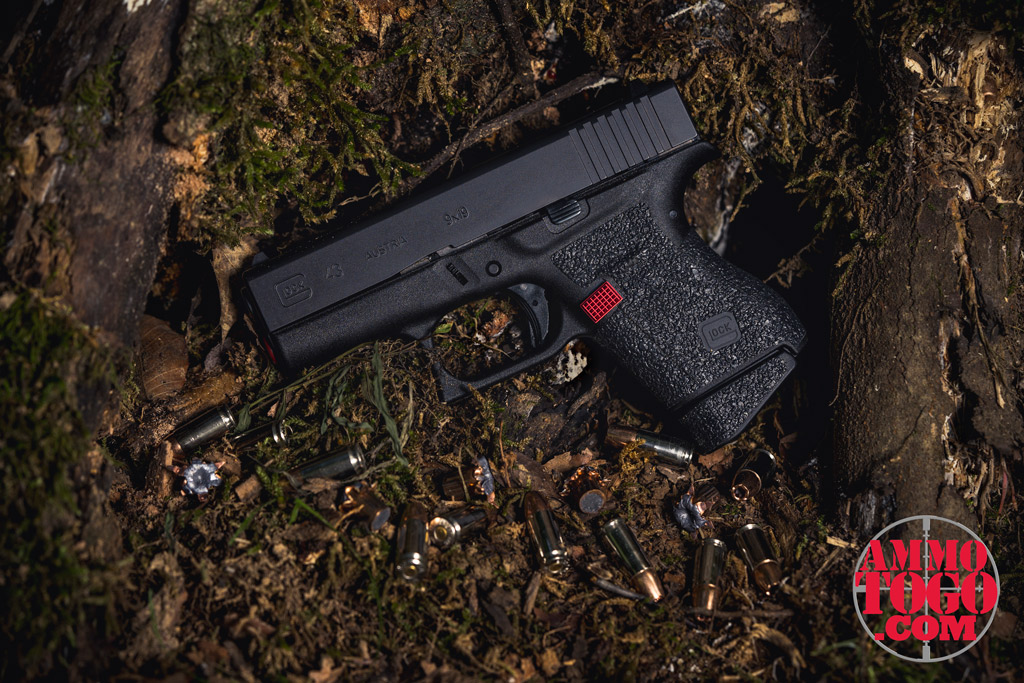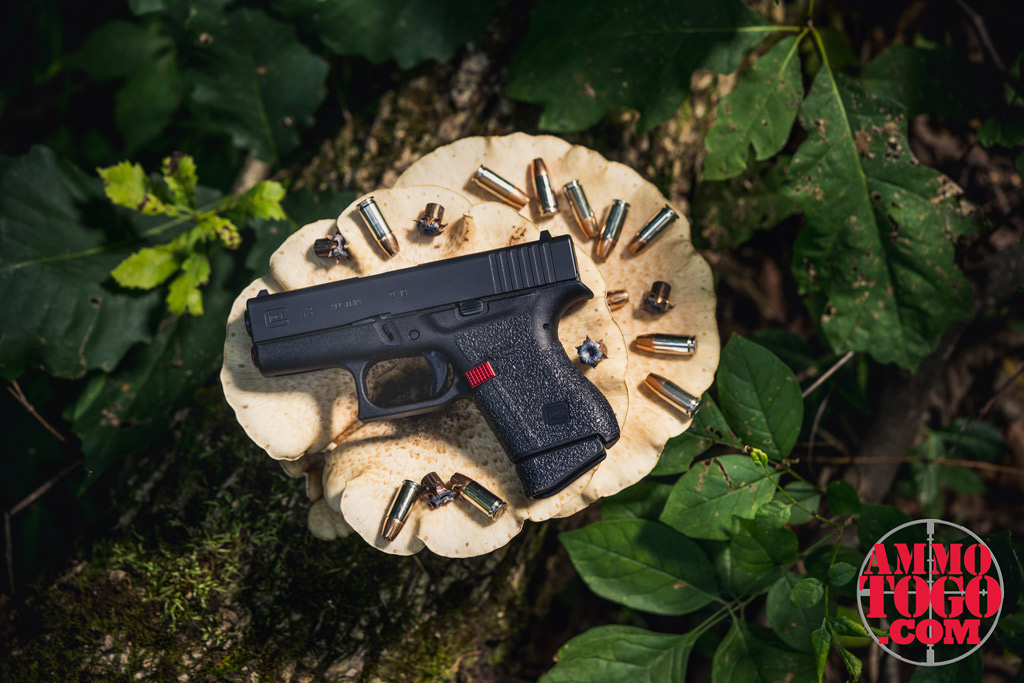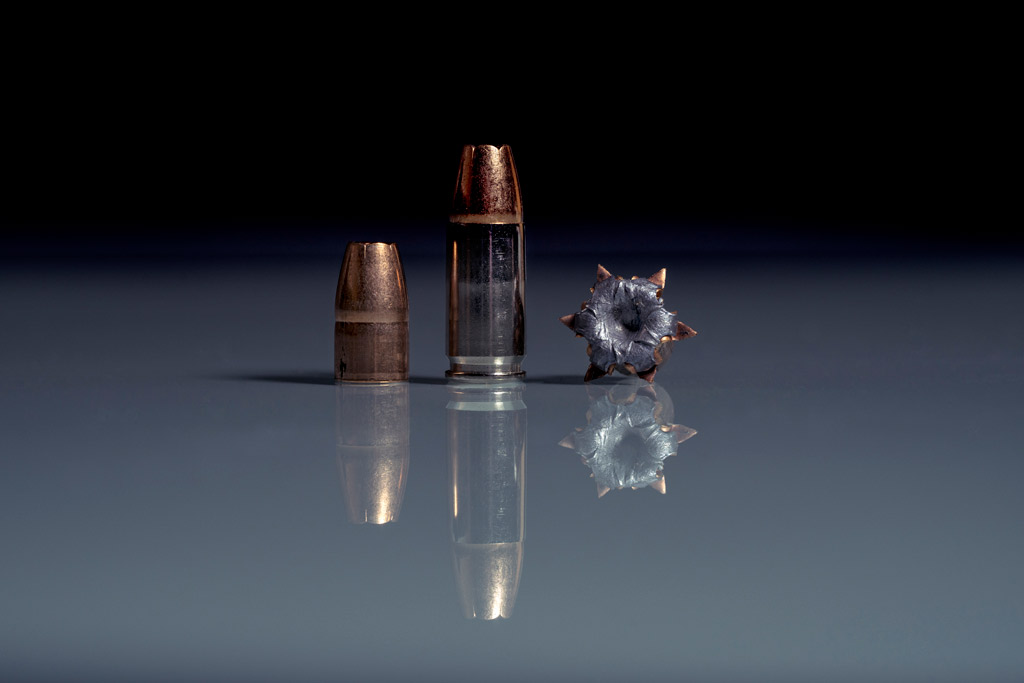We examine the results of our massive gel testing project to help you determine the best 9mm ammo for self-defense for your needs. Read on to examine the factors that matter when choosing a self-defense load and what you might be wise to carry yourself.
Best 9mm Ammo for Self-Defense
After extensive testing and analysis, we believe the best 9mm ammo for self-defense is Federal Premium Law Enforcement HST with 147-grain hollow points.
Black Hills Barnes XP +P with 115-grain hollow points make for another really good option.
Speer’s Gold Dot line-up of ammo is a solid choice as well. You can score their 115 grain 9mm ammo here.
All of these rounds largely fall within the Federal Bureau of Investigation’s guidelines for penetration and expansion when tested in ballistic gelatin.

Best 9mm Self Defense Ammo for Penetration
-
Hornady American Gunner, 115-grain Jacketed Hollow Point: 17.72 inches
-
Federal Premium Law Enforcement, 147-grain HST Jacketed Hollow Point: 16.9 inches
-
Federal Premium HST Micro, 150-grain Jacketed Hollow Point: 16.82 inches
-
Winchester Range Talon, 147-grain T-Series Hollow Point: 15.88 inches
-
Speer LE Gold Dot, 147-grain Hollow Point: 15.54 inches

Best 9mm Self-Defense Ammo for Expansion
-
Black Hills Barnes XP +P, 115-grain Hollow Point: .69 inches
-
Federal Premium Law Enforcement HST, 147-grain Jacketed Hollow Point: .64 inches
-
Federal Premium LE Tactical HST +P, 147-grain Hollow Point: .63 inches (More on +P ammo in this article)
-
Remington Golden Saber, 147-grain Bonded Jacketed Hollow Point: .58 inches

Best 9mm Self Defense Ammo for Average Velocity
-
MagTech Guardian Gold +P, 115-grain Hollow Point: 1,166 feet per second
-
Black Hills Barnes XP +P, 115-grain Hollow Point: 1,084 feet per second
-
Hornady Critical Defense, 115-grain Hollow Point: 1,064 feet per second
-
Hornady Critical Defense Lite, 100-grain FTX: 1,052 feet per second
-
Winchester Ranger Talon T-Series, 147-grain Hollow Point: 945 feet per second
How We Picked The Best Ammo for Self Defense
To research the best 9mm ammo for self-defense, let’s dive deeper into our 9mm ammunition ballistic gel testing data. This information was gathered using a concealed carry-sized pistol that had a 3-inch barrel.
If your concealed carry gun features a longer or shorter barrel, you could see a drastically different performance from your carry ammo than what we witnessed in the testing.
The tests examined three key factors for stopping a threat:
- Penetration depth
- Expansion diameter
- Muzzle velocity
Law Enforcement Agencies’ Performance Standards

There are many different opinions on what makes an effective personal-defense round. Some desire expansion, some want advanced penetration, while others look towards muzzle velocity.
So, where should you start? A good reference point is the FBI’s performance standards. The Federal Bureau of Investigation looks for penetration between 12 and 18 inches and wants the largest expansion diameter possible.
Using the FBI’s standard as our guide, we can help you determine the best 9mm ammo for self-defense.
9mm Penetration
When attempting to stop a threat, penetration remains an extremely important statistic. To deliver an effective wound channel that neutralizes your target, you need a cartridge that will penetrate deep enough to cause significant blood loss and trauma to the body. To meet the FBI’s standards, a bullet must penetrate an average of at least 12 inches.
Over-penetration, however, is also a concern. Over-penetration can cause significant injury to someone behind a barrier, and it’s also possible for a bullet to over-penetrate an attacker and harm someone behind. This is an unlikely situation, but it can happen. For this reason, the FBI standards limit penetration to less than 18 inches in their ballistics testing. Of course, you might not have the same concerns about over-penetration. If you live alone and don’t use a concealed carry pistol when out in public, the threat of over-penetration is not nearly as severe.
For our best 9mm round for penetration, we looked at the deepest-penetrating bullets that do not go over an average of 18 inches. With the right balance of penetration, the bullet will perform as needed at the target and impact vital organs, giving the best chance at stopping a threat.
9mm Hollow Point Expansion
One of the most important factors to consider for defensive ammo is shot diameter. When hollow point bullets or soft-nose bullets strike a target, the kinetic energy and force of the shot cause the bullet to expand, creating larger wound channels and greater internal damage. In most cases, the larger the expansion diameter, the more effective a cartridge will be at stopping a threat.
Many factors will impact how a bullet expands or “mushrooms.” The construction of the bullet can limit or enhance the bullet’s ability to expand.
Muzzle velocity and kinetic energy are also important factors for expansion. Generally, the higher these stats go, the more a bullet will expand. Therefore, the quality of hollow point bullets as well as target distance (which both affect muzzle velocity and kinetic energy), can impact the expansion diameter of the hollow point round.
For successful expansion, a generally-held minimum (not an official standard) is 1.5 times the hollow point bullets’ original diameter. For 9mm ammunition, this means an expansion diameter of 13.5 mm, or .53 inches, is the regularly-accepted minimum.
To make our list, we looked at the largest-diameter shots that were within the penetration range of 12 to 18 inches.
The 9mm Luger Barnes 115-grain +P TAC-XPD Hollow Point, which has the highest expansion (.7 inches), was disqualified because it did not reach 12 inches of penetration. Likewise, the Federal Premium LE 124-grain HST Jacketed Hollow Point would have been on the list (.62 inches diameter) but it over-penetrated at 18.46 inches.
9mm Velocity
Muzzle velocity is the final factor we will look at for the best 9mm defensive ammo. Because it so heavily impacts penetration, muzzle velocity also needs to be well balanced. Too little, and the bullet won’t penetrate the target properly. Too much, and you increase the risk of over-penetration.
Muzzle velocity not only creates penetration but also drives expansion. With proper muzzle velocity, the bullet is allowed to expand to the desired diameter. Muzzle velocity also ensures a high amount of energy is delivered to the target, which can significantly impact the “stopping power” of the projectile.
Once again, we made this list using only the bullets that fell within the FBI’s standard of 12 to 18 inches of penetration. We also eliminated handgun bullets that do not expand to at least .5 inches, which is slightly lower than the generally-accepted expansion minimum for 9mm self-defense ammunition.
Final Thoughts

9mm self-defense ammo is one of the most commonly-used calibers in the world. It’s powerful, effective, and manageable, which makes it good for self-defense, law enforcement agencies, and target shooting. Due to its relatively small size, it is also an excellent option for concealed carry ammo. Pair that with outstanding designs from manufacturers like Glock and Sig Sauer, and there’s no questioning why it’s among the best sellers at Ammo To Go.
There are many 9mm ammo options available for sale. This can make sorting facts and actual performance from the marketing buzz a little bit difficult.
With the right information, however, you can choose the best 9mm ammo for self-defense or practice ammo. Keep in mind, every self-defense situation is different and while there are credible resources we can lean on to help advise us – it’s important you understand your needs and formulate an ammo plan that makes the most sense for you.





